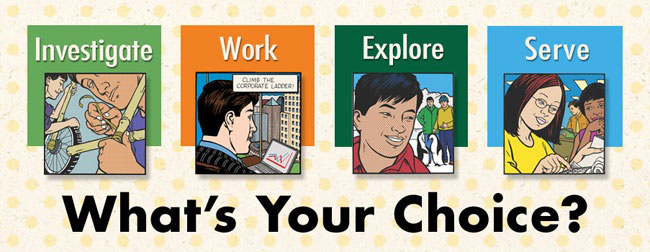21st Century Learning Emphasizes ExplorationBy Dale Short
|
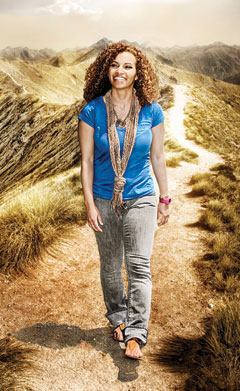 |
|
Biology major Nicole McLean spent a summer of her senior year studying and doing research at Otago University in New Zealand, where she found some things surprisingly familiar. Read more |
When UAB students head to class these days, odds are they have more technological power in their backpacks than NASA harnessed for the entire Apollo moon mission.
But technology is only one part of the revolution in education that’s taking shape at UAB. All across campus, students are choosing from learning options that their parents’ generation could not have imagined. They can get research experience as early as their freshman years and publish their findings while they are still undergraduates. They can select among five different honors programs specifically designed to produce future scientists, physicians, and global leaders; a menu of Study Away programs in every continent on Earth; and dozens of courses that offer concrete ways to make a difference in their own communities.
In UAB lecture halls, netbooks are now as common as notebooks, and students can confer wirelessly with their professors in class or from home. Thanks to small devices called handheld wireless response pads (also known as “clickers”) hundreds of students can interact with a professor and weigh in on the subject matter at the same time. Think of it as a combination of discussion and pop-quiz via remote control.
The new, 200-computer Mathematics Learning Laboratory is a prime example of new trends in digitally assisted instruction. Students can use interactive software to view detailed solutions for the problems that are giving them trouble, view the textbooks online, and e-mail professors with questions. Monitoring software gives instructors and advisors the ability to track student progress—everything from quiz grades to attendance—daily. The lab is credited with playing a major role in soaring success rates in pre-calculus courses at UAB, which have jumped to 78 percent from 34 percent in 2006.
Ahead of the Curve
Restructured mathematics and composition courses are a sample of many improvements in student learning experiences across campus, says provost Eli Capilouto, D.M.D., Sc.D., M.P.H. “Our creative and can-do faculty are delivering programs that help us attract the best and brightest students and teach those students the skills they’ll need to advance in the future,” Capilouto says.
“Our graduates will face a diverse range of intellectual, political, cultural, and technological challenges,” he continues—challenges described in the recent book The Global Achievement Gap by Tony Wagner, in which the landscape of the future is described as “ ‘flat, digitally hyper-connected, and flooded with information,’ ” Capilouto says.
To succeed in the new digital world, Wagner argues, a person must excel in seven key areas: critical thinking and problem solving, collaboration across networks and leading by influence, agility and adaptability, initiative and entrepreneurship, effective oral and written communication, assessing and analyzing information, and curiosity and imagination.
While the quantum leap in connectedness has caught many institutions off guard, UAB is ahead of the curve in meeting these needs with learning innovations; extracurricular experiences that develop leadership and management skills; experiential learning and improved mentoring; and student support. Additionally, engaging “capstone courses” prepare our students to synthesize, integrate, and apply knowledge in real-world matters. “Developing these critical-thinking skills can best prepare our graduates for 21st-century knowledge careers—in some cases, for jobs we have not even imagined,” Capilouto says.
Service With a Smile
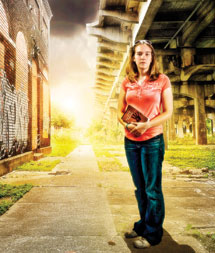 Allison Borden's experience with service learning began with her forgetting most of what she thought she knew. "My misconceptions about the homeless were blown out of the water," she says. Read more |
But even before their senior years, UAB students can put their classroom training to the test in one of the university’s growing number of service learning courses. These classes—there are now 23 officially designated at UAB—cover a variety of themes and experiences, but each combines enhanced academic learning, purposeful civic learning, and meaningful service to the community, says Norma-May Isakow, director of UAB’s Office for Service Learning. “By ‘civic learning,’ I mean students putting their skills to work by helping their local community,” Isakow says.
In the Biology Field and Lab Science course, for example, students help remedy the deficiencies of science education in Birmingham’s inner-city schools by offering weekly mentoring sessions for students from kindergarten through fifth grade. Physical Activity Programming pairs students with disabled community members to create fitness, sports, and recreation opportunities.
Students in the Civic Engagement course have pursued activities including inner-city food production at Birmingham’s Jones Valley Urban Farm. “One of our major focuses is hunger and food security,” Isakow adds. “There’s a wide range of differences between what’s relevant and meaningful to various neighborhoods in that regard. The key is that we collaborate closely with the members of a community to determine what their specific needs and priorities are.”
Around 1,000 students took part in designated service learning courses (or courses that have the requisite elements but have not been officially designated) in the 2009-2010 school year, Isakow says.
Long-Distance Education
The ultimate out-of-classroom experience used to be known as Study Abroad, but even that’s changed in the brave new world, says Josh Carter, M.A., director of UAB’s Office for Study Away.
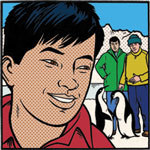 Sophomore honors student Andrew Douglas traveled to Antarctica in December 2009 as part of the Antarctic Marine Ecology course offered through UAB’s Study Away program. Classes were taught aboard the cruise ship Minerva by UAB biology professor Jim McClintock, Ph.D., who led passengers on a Climate Change Challenge. The Antarctica course will be offered to all UAB students again in December. Sophomore honors student Andrew Douglas traveled to Antarctica in December 2009 as part of the Antarctic Marine Ecology course offered through UAB’s Study Away program. Classes were taught aboard the cruise ship Minerva by UAB biology professor Jim McClintock, Ph.D., who led passengers on a Climate Change Challenge. The Antarctica course will be offered to all UAB students again in December. |
The relabeling, Carter says, is due to expanded options and student access. For some students, the idea of studying overseas is a bit daunting, he explains—and “we have found that studying in another country is no longer the only way for a student to be immersed in an entirely different culture.” With the Washington Center program in Washington, D.C., for example, students can spend up to seven weeks interning in various governmental and nongovernmental agencies, attending seminars led by world leaders, visiting foreign embassies, and attending press briefings.
International exchange programs are still the cornerstone of the off-campus learning experience, says Carter. “UAB is one of the few universities anywhere in the world that can offer students learning opportunities on every continent, including Antarctica,” he notes. Expanding choices—and an increasingly international-minded bent in the university’s undergraduate population—have boosted the number of students taking part in Study Away from 12 students in 2003 to nearly 200 in 2010.
“What we’re moving toward, in general,” Carter says, “is to help students become active and responsible global citizens, to help them learn people skills, patience, tolerance—all those things that they will require for their life in the world. Those very disparate areas used to be approached separately in the classroom, but through our truly globalized ‘experiential learning’ Study Away programs, they can all be melded together into each person’s education.” [Check out a list of Study Away programs here.]
The Value of Experience
 A unsolicited letter helped earn Arielle Stewart her dream internship in New York City. Read more |
Experiential learning also is the focus of the university’s latest honors program (see related story, Test Drive Your Career). “UAB has changed significantly over the past several years,” says Philip Way, Ph.D., associate provost for undergraduate programs. “One of those changes is an increase in the quality of the entering student body. As a result, there’s an increase in demand for honors opportunities. We’ve responded by creating additional small, focused thematic honors programs in science and technology, global and community leadership, and experiential learning.”
The new programs are all based on the successful model of UAB’s University Honors Program, Way notes. “We made the strategic decision that, rather than expanding it, we would set up additional small programs that will maintain the atmosphere of a close-knit community of scholars.”
Immediately, If Not Sooner
There’s no single magic bullet for designing new learning strategies, notes Christopher Reaves, Ph.D., director of UAB’s Office for Undergraduate Research. “The phrase ‘learning by doing’ is a very old one,” Reaves says, “but hands-on practice and research are still the most tried and true ways to learn.”
During the 2009-2010 school year, roughly 850 undergraduates took part in research activities at UAB. They weren’t washing beakers, either: At UAB’s annual spring research fair in April, some 150 students representing 30 majors explained their roles in studies that analyzed the brain function of autistic children, decoded the chemical origin of restless legs syndrome, tracked the decline in coral species in Fiji, and perfected a crowd-pleasing mechanical hand, among other topics.
“Just the process of explaining your work is a great intellectual exercise,” says Reaves, who launched the spring Expo fair in 2008 [learn more about the Expo in this UAB Magazine feature]. “It makes you think about familiar material in a different way and enhances your understanding of it. There’s no substitute for doing hands-on research and then presenting to other people what you’ve learned and getting those people’s immediate feedback.”
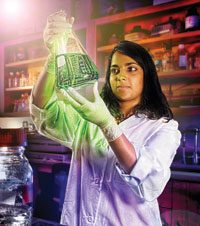 Beginning in her junior year, Sandhya Kumar got an up-close look at the groundbreaking work in UAB's Autism Brain Imaging Lab—but she was much more than an observer. Read more |
The term “immediate” shows up often in the new literature of learning. Because life in the 21st century is so much more fast-paced than just a decade ago, time is increasingly of the essence—in face-to-face interactions between students and their potential employers, for example, or in applying to professional and graduate schools.
“We’ve gotten to be a microwave society,” Reaves says. “If you give a potential employer a long CV, a cover letter, and lots of other data, they can be turned off pretty quickly. If you can’t engage their interest right up front, you’re usually not going to get very far. That not only goes for employers, but for grad school applicants as well.”
Summer=Hire
How does one end up meeting potential employers in the first place? That’s the purview of such programs as UAB Career Services, which encourages students to explore career options, gain experience in their chosen fields, and prepare for job and graduate school searches. Exposure to hiring organizations can occur as early as a student’s freshman year, says Career Services director Suzanne Scott-Trammell. Shadowing programs give students a warts-and-all look at their chosen profession—in time to shift their majors if they find it isn’t what they were imagining. These hands-on previews are gaining in popularity; in 2009-2010, 262 pre-nursing students participated in shadowing programs, up from 192 the previous year, and other majors have expanded shadowing opportunities this fall, Scott-Trammell says. More in-depth mentoring programs, in which students are matched with alumni and community professionals, are also available; in spring 2010, 60 UAB students took part.
Today, says Scott-Trammell, “internships or co-ops are often viewed as entry-level positions where students and hiring organizations can test drive the ‘fit’ to see if there is a good match.” But the basics of finding productive employment haven’t changed, Scott-Trammell adds. “The two main questions any employer asks are ‘Who are you?’ and ‘What value can you add?’
“The most important thing students can do is know their story,” she continues. “They have to know why they chose that career area and articulate how their experiences at UAB are helping them to become stronger leaders in the field.” Employers, Scott-Trammell says, “need to get a feel for who the student is and see a demonstrated ability to think critically, work with diverse teams, and synthesize information into a presentation of accomplishments. That is what will get you hired and what leads to lifelong career success.”
The Greater Good
Capilouto points to innovations in graduate programs and in the university’s health schools as further evidence of UAB’s commitment to put “students first.” Engaging, inquiry-based curricula across the university are preparing students for successful careers and lives of meaning and purpose, he says. “Enrollment, retention, and student performance are all on the rise. But beyond the numbers are all the compelling stories of citizenship, creativity, critical thinking, and service for the greater good.”
See a slideshow of all images from this story
